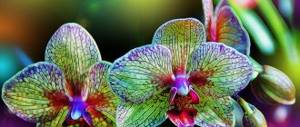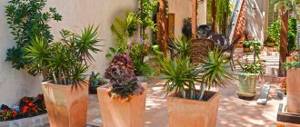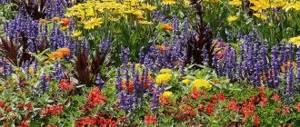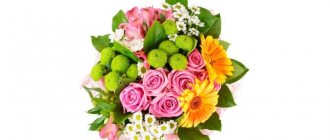Every gardener wants to see his garden plot well-groomed and blooming. Bouquet planting of a flower bed is an ideal solution that allows you to admire a beautiful garden throughout the warm season. But before you create a bouquet flowerbed, you need to determine the planting scheme, care rules, and which plants are suitable for this.
Features of bouquet flower planting
Planting a flower bed in a bouquet manner will turn a small area into a piece of paradise. Very often, gardeners advise maintaining a distance between plants. This method gives the flowers maximum comfort, but will not allow you to turn the flowerbed into a blooming oasis.
When bouquet planting, 3-4 seedlings are placed in one hole. But before choosing plants, you need to know their varietal characteristics. You cannot grow moisture-loving and drought-resistant specimens and plants that grow in different lighting conditions in the same hole.
When creating a bouquet bed of flowers grown from seeds, the seed is placed in furrows, which must be placed at a short distance. The main feature will be dense and abundant sowing. With such a planting, bare soil will not be visible, which will give the flowerbed the effect of a flowering carpet. After sowing the seeds, the soil is shed generously. Caring for seedlings involves regular watering and feeding.
What flowers are sown with seeds?
There are a large number of flowers that need to be planted with seeds in open ground.
Most often, such planting is carried out for the following plants:
- morning glory;
- sweet peas;
- calendula;
- Adonis;
- Clarkia;
- matthiol;
- cornflowers;
- poppy;
- aster;
- marigold.
Almost all flowers that are planted using seeds can be sown in open ground without prior germination. However, most often the seeds are selected from perennial plants, which do not require further planting in the future.
Benefits of bouquet planting
A bouquet flower garden will help transform any place, since by planting a variety of varieties you can completely change the appearance of your garden plot.
A flowerbed in the form of a bouquet of flowers has a number of advantages:
- A simple technology for creating flower beds that has become popular all over the world. To get bright colors and amazing aromas, you need to plant plants in groups, then the appearance of the flowerbed will significantly improve.
- Growth and development in a bouquet flower garden occurs in a balanced and harmonious manner.
- The absence of weeds is the main bonus of bouquet planting. The roots of plants intertwine, creating one powerful root system through which it is difficult for weeds to break through.
Planting scheme and care
To make a flowerbed in the form of a bouquet of flowers, you need to know the rules of care and determine the planting pattern.
Some rules for creating a bouquet flower garden:
- It is better to cultivate the flowerbed in a sunny place; the soil for planting should be loose, nutritious, and well-drained.
- When planting different varieties, it is necessary to take into account the varietal characteristics of each species in order to adjust watering.
- In order for the bouquet flower garden to look well-groomed, it is necessary to carry out regular loosening and removal of weeds.
- Every spring, the aged bushes are divided, since without this beautiful flowering cannot be achieved.
- It would be useful to fertilize: in the spring - with nitrogenous fertilizers, during flowering - with phosphorus-potassium fertilizers.
Important! To make flowers for a bouquet flower bed look well-groomed, faded inflorescences are regularly removed.
To create a beautiful flower garden, you need to place the plants correctly:
- The background is tall, such as: eupatorium, delphinium, bush asters. If the flower garden is located next to a fence or buildings, then climbing roses, clematis, and sweet peas can be planted in the background.
- Central part - in the center there are medium-sized upright specimens: phlox, asters, irises, bells.
- Foreground - low-growing or ground cover plants, such as hosta, viola, marigolds, thyme, cloves, alpine phlox.
Planting separated tubers and rhizomes
Most perennials require periodic division of bushes. This procedure is performed to rejuvenate plants, because Many of them age after a few years and lose their decorative properties. Therefore, you can create a new flower garden from those that you already have growing. It is enough to dig up and divide the old tubers and rhizomes into several parts and plant them again in the ground.
From a financial perspective, this method of spring flower planting may be the most profitable for you. Since there is no need to purchase seeds and spend money on growing seedlings.
You can divide and plant in the spring those perennials that bloom in summer and late autumn. In reference books on this matter, as a rule, there are recommendations for each specific plant.
In order to carefully dig up plants, use a pitchfork, because... a shovel can damage the roots. And also, to preserve the roots, it is better to dig up the bushes with a large lump of earth.
The bushes need to be divided in such a way that each section is approximately the size of a fist, and always includes buds and roots.
Before planting, all wounds and sections of the cuttings are powdered with charcoal to protect against fungal diseases, and left to dry a little (about an hour). The separated tubers and rhizomes are planted at the same depth, but preferably in a new area.
Preparing soil for a flower garden
It is advisable to prepare the soil for the flower garden in the fall. But if you didn’t do this in the fall, then prepare it 2-3 weeks before planting the flowers. The soil ready for planting should be fertilized, loose, and slightly moist.
First, the area needs to be dug up to a depth of 30-40 cm and all weeds removed. To cultivate the land, it is necessary to add additives in the form of baking powder and fertilizers. Peat, compost and loam are added to sandy or sandy loam soil. If the soil is clayey, then add peat, compost, humus, sand or bone meal.
It is recommended to add compost, as well as manure, in late autumn, and humus when planting in spring. If there is no organic matter, you can apply mineral fertilizers. Then phosphorus-potassium fertilizers are applied in the fall, and nitrogen fertilizers in the spring.
What flowers to plant in a flowerbed using the bouquet method
In order for the flowerbed to be beautiful and bloom for a long time, you need to choose the right plants.
The following composition options are available:
Shrub diversity. Specimens with differently colored foliage and bark are suitable for this composition. Hawthorn, barberry, spirea, and forsythia are used for planting.
Fruit composition. To create a fruit composition, apple, pear, cherry and plum are used. This planting has 2 advantages: pollination and space saving. But there is also a minus - poor lighting. To ensure that the plants receive enough light, the branches are spread apart as they grow and secured to the ground with ropes.
Spring mood - in early spring, the flower garden shows its beauty thanks to small-bulbed specimens: tulips, crocuses, muscari. Next, the flower garden is covered with miniature primroses, daisies, and pansies. At the beginning of summer, daffodils, hyacinths and hazel grouse bloom. Tall perennials look great next to them: swimsuit, magnificent dicentra. The foreground is covered with tuberous anemones, ground cover phlox, and hosta.
Summer colors. To make bright colors delight you throughout the summer, the bouquet flower bed can be planted with lilies, daylilies, roses, hydrangea, delphinium, cornflowers and astilbe.
Autumn variety. When the heat subsides, a new wave of flowering begins: bush asters, late phlox, chrysanthemums. To extend the summer days, you can plant plants with repeated flowering, such as ageratum, begonia, carnation, and remontant rose.
In bloom all season. If you plant decorative onions and craspedia in a flower garden, you can admire the delicate, beautiful balls with a variety of colors from the end of May until frost.
From the end of May, decorative yarrow begins to bloom, which will not only decorate the garden plot, but also attract pollinating insects.
Suitable perennials, annuals, ornamental shrubs for decoration
You can use any type of plants to decorate your home area. They should combine beautifully and not suppress each other's growth.
Annuals grown by sowing in open ground
These plants can be planted in the ground when it is sufficiently warmed up by the rays of the spring sun, and after the snow melts, the soil moisture is still high:
- multi-colored pyrethrum;
- calendula;
- nasturtium;
- marigold;
- clarkia graceful, terry;
- cleome;
- double cornflower;
- cosmos.
Many annuals are not capricious, do not require special care and can withstand dry periods. Most species can reproduce by self-seeding.
Photo: annual flowering plants
Bright calendula inflorescences will decorate any flower garden
Annual Clarkia graceful attracts attention
Pyrethrum comes with multi-colored petals
Cleome is an unusual and bright flower
Marigolds bloom until the first frost
Nasturtiums come in bright and pastel shades
It is recommended to sow seeds of annual plants densely into the ground, and when seedlings appear, thin them out if necessary.
Annuals grown from seedlings
There is a group of annual plants whose growing season until flowering takes 2–3 months. In order for the seedlings to go through the stages of development they need by the summer season, seeds for seedlings are sown in special greenhouses in winter. Here are some representatives of this group suitable for growing in the front garden:
- ageratum;
- begonia;
- alyssum;
- balsam;
- salvia;
- Snapdragon;
- petunia;
- verbena;
- celosia.
Garden annuals are famous for their tireless flowering. Most species are able to decorate flower beds not only throughout the summer, but also in early autumn.
Photo: annuals grown by seedlings
Alyssum is a compact plant used for borders.
Balsam is a low-growing and unpretentious annual
Ageratum is a fragrant member of the aster family.
Begonia will delight you with its beauty all summer long.
Petunia is a traditional flowerbed plant.
Salvia has decorative leaves and inflorescences
Plants grown by seedlings and transferred to open ground begin flowering in early spring, immediately after the threat of frost has passed.
Flowering biennials
This group includes plants whose development cycle takes place within two years. In addition, gardeners include among them species that degenerate after 2–3 years and do not resume their growth. The following varieties are suitable for decorating a flower garden:
- daisy;
- forget-me-not;
- viola;
- Turkish cloves;
- night violet (hesperis female);
- purple foxglove;
- mallow;
- rudbeckia;
- nivyanik.
A peculiarity of biennials is that in the first year of life they form roots, stems and a leaf rosette. Flowering in these species begins only in the second year, after which the plant completes its life cycle.
Photo: biennial flowering plants
Daisy is resistant to diseases and insect pests
Forget-me-not does not require special care, but is light-loving
Viola can grow in partial shade, but prefers fertile soil
Nivyanik is able to enliven any flowerbed with its appearance
Mallow is a tall, unpretentious plant.
Rubdecia can be a soloist or a background plant in a flower bed
Biennials can be grown by sowing seeds or using seedlings. Biennial seedlings are planted last, when seedlings of other plants are already placed in the flower garden.
Perennial flowering plants
Low maintenance plants can grow in the same place for many years. In landscape design, perennials often form the basis of a flower garden. This is the most extensive group of representatives of flowering plants, here are some of them:
- phlox;
- chrysanthemums;
- perennial asters;
- peonies;
- yarrow;
- dicentra;
- astilbe;
- delphinium;
- clematis;
- day-lily;
- hydrangea;
- rose.
According to the timing of flowering, perennials are divided into spring, summer and autumn species. Some specimens can bloom several times per season if dry inflorescences are removed in a timely manner.
Photo: flowering perennials
Phlox blooms from July to August
Chrysanthemums bloom at the end of August and bloom until frost
Perennial asters bloom in late summer and fall
Peonies delight with their flowering from the end of May and throughout June
Dicentra can grow in the shaded corners of the flower garden
Hydrangeas can compete with roses for their beauty of flowering.
These plants reproduce by seeds or vegetatively. Small-sized perennials can become a border in a flower bed, while tall and large species are used as background varieties.
Herbaceous decorative deciduous perennials
They are valued for the beauty of their foliage, but some specimens can also please you with their flowering. In landscape design, such perennials are used as a background and planted next to bright flowering plants. The following types are used to decorate flower beds:
- fern;
- host;
- Rogers;
- astilboides;
- Kupena multiflorum;
- buzulnik.
Perennials with decorative foliage are grown using the seedling method. Many of them do not like direct sunlight, preferring semi-shaded places in the flower garden. This is especially pronounced in varieties with yellow or white patterns on the leaves.
Photo: herbaceous perennials
Fern grows in moist and shaded areas
Astilbodies - a plant with very large leaves
Rogersia has beautiful foliage and can bloom
Hosta is a common foliage plant for flower bed design.
Buzulnik blooms with yellow inflorescences at the end of June
Kupena multiflora can grow and bloom even in the shade of trees
Herbaceous ornamental perennials will help to disguise with spectacular foliage in the front garden those plants whose flowering period has ended and their appearance has ceased to be attractive.
Coniferous and evergreen species
Plants of this group have a decorative appearance throughout the year. Compact varieties are used in the flower garden; they are planted in small quantities so as not to create excessive shading near the house. Evergreen plants include:
- juniper;
- thuja;
- cypress;
- mountain pine;
- cedar dwarf;
- fir;
- spruce;
- larch;
- Canadian hemlock.
If the plant is tall, then after planting in a permanent place you can restrain its growth by periodically pinching or pruning the crown.
Photo: decorative evergreens
Cedar dwarf - a spectacular plant
Cypress - loves warmth and sunlight
Juniper - an unpretentious species
Mountain pine - frost resistant
Canadian hemlock - an unpretentious evergreen conifer
Thuja - does not tolerate frost well, needs shelter
Evergreen crops are undemanding in care and take root well in the middle zone. Heat-loving species need to be protected from frost in winter, but there are also varieties that tolerate wintering well on their own.
Shrubs and trees with decorative foliage
The beautiful foliage and color of the bark make these plants desirable for decorating the front garden. Some species are fruit-bearing, which is their additional decorative advantage. Designers consider such plantings to be a good addition to coniferous and evergreen plants:
- euonymus;
- red Japanese maple;
- viburnum;
- jasmine;
- lilac;
- Rowan;
- broom;
- barberry;
- weigela;
- spirea;
- snowberry.
These plants can decorate a flower bed not only in summer and autumn, but also in winter, especially those species whose bark is brightly colored.
Photo: bushes and trees
Barabaris is often used as a hedge
Lilac bushes are a traditional decoration for the front garden
Euonymus has a decorative appearance due to its variegated foliage.
The snowberry attracts attention not only in summer, but also in autumn
Weigela - flowering shrub with decorative leaves
Spirea - famous for the abundance and beauty of its inflorescences
Dwarf varieties of ornamental shrubs are planted at a distance of 70–80 cm from each other, and tall specimens will require at least two meters of free space.
Photos of beautiful bouquet flower beds
To have an idea about bouquet planting of flowers in a flower bed, you can study photos of various design options:











